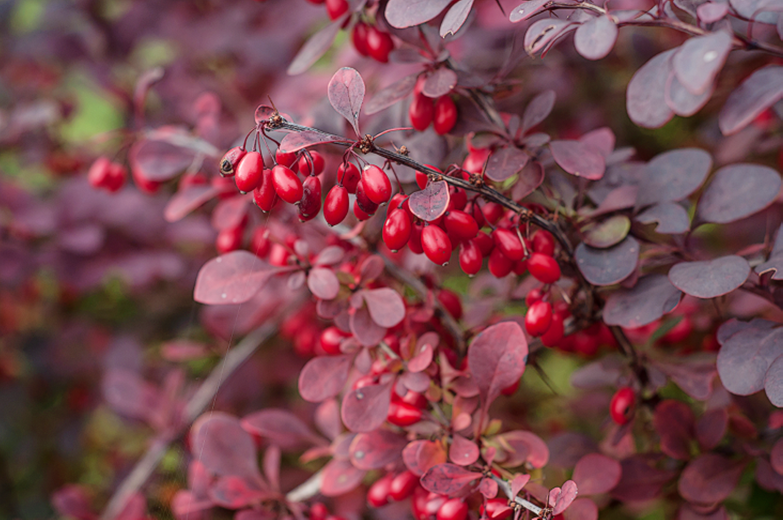Berberis thunbergii are deciduous shrubs which look particularly fabulous at this time year, producing highly coloured leaves, and often berries which last well into winter. These berries are actually edible and rich in vitamin C, though because they are very acidic, they are not widely consumed by people. They are an important food for many small birds though. They get their other name of ‘barberry bush’ because of their vicious spines. This makes them useful as an impenetrable barrier hedge and may be another reason why the berries aren’t harvested much!
Like the colourful Japanese Maple, they originate from Eastern Asia. Berberis vary in colour according to the cultivar and variety. The common Berberis thunbergii have green leaves in spring and summer which turn rich burgundy in autumn. If you’d like the purple colour all year round choose Berberis thunbergii f. atropurpurea, which has purple leaves in spring that turn rich mahogany in autumn. Though Berberis are generally grown for their autumn colour, they are a hard-working shrub, and produce a mass of tiny yellow flowers in spring, providing interest at either end of the year.
There is a Berberis for most gardens: They can grow to a maximum height and spread of 1.5m, but there are now dwarf forms which grow to just 50cm, try ‘Tiny Gold’ or ‘Lutin Rouge’. They grow best in full sun but also tolerate partial shade. They do well in most soil types, and even do well in drought, but will thrive particularly well in well drained moist soil. Their easy-going nature extends to aftercare, as they are generally pest-free and require little attention, other than a trim to tidy them up periodically. If you don’t have much space or mainly grow in containers on a balcony ‘Lutin Rouge’ does very well in a pot.
Mid-September to October, and mid-March to April are the best times to plant so now is the perfect time. Dig a hole double the width of the root ball. Sprinkle in a handful of blood, fish and bone and work into the ground. Place the plant into the hole, fill in with soil around the root ball and firm the soil down gently but firmly, finish by watering well. They will appreciate being mulched with well-rotted organic matter in late spring, but they aren’t fussy; grass cuttings will do fine.
My absolute favourite is Berberis thunbergii f. atropurpurea ‘Admiration’. This lovely plant has extremely attractive orange-red foliage, edged with yellow, and forms an attractive mound shape. Its masses of small yellow flowers in the spring followed by purple-crimson berries in autumn make it the most perfect Berberis in my opinion.
Happy gardening.

